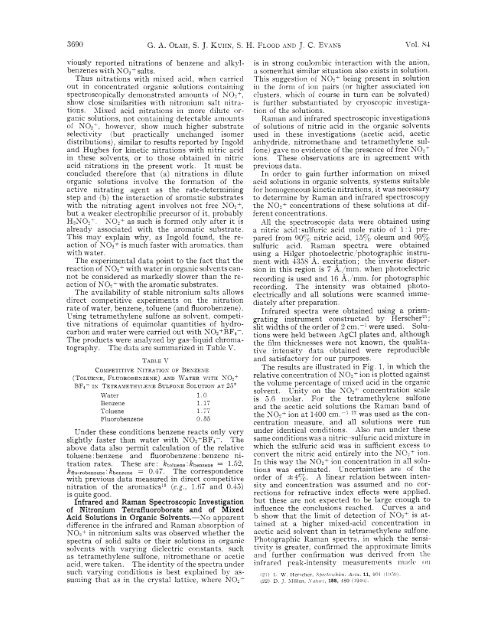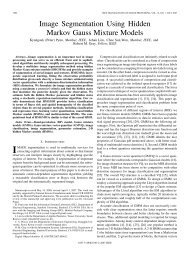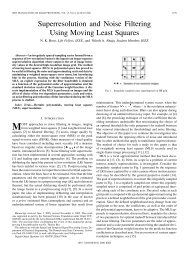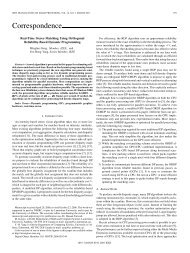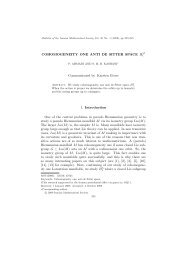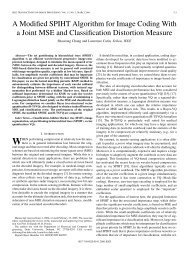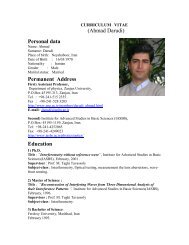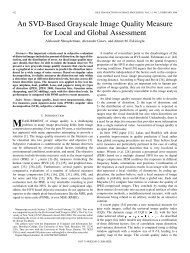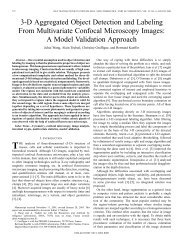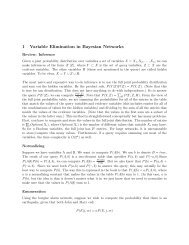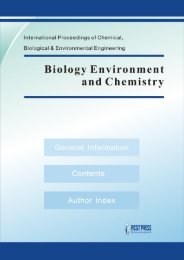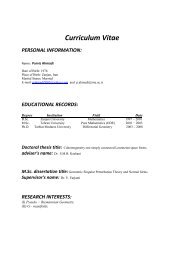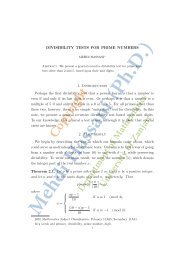Aromatic Substitution. XIII.la Comparison of Nitric Acid and Mixed ...
Aromatic Substitution. XIII.la Comparison of Nitric Acid and Mixed ...
Aromatic Substitution. XIII.la Comparison of Nitric Acid and Mixed ...
Create successful ePaper yourself
Turn your PDF publications into a flip-book with our unique Google optimized e-Paper software.
3690 G. A. OLAH, S. J. KUHK, S. H. FLOOD AND J. C. E~~1n-s 1-01, s4<br />
viously reported nitrations <strong>of</strong> benzene <strong>and</strong> alkyl-<br />
benzenes with NO2+ salts.<br />
Thus nitrations with mixed acid, when carried<br />
out in concentrated organic solutions containing<br />
spectroscopically demonstrated amounts <strong>of</strong> NO2+,<br />
show close simi<strong>la</strong>rities with nitronium salt nitr:t-<br />
tions. <strong>Mixed</strong> acid nitrations in more dilute or-<br />
ganic solutions, not containing detectable amounts<br />
<strong>of</strong> NO:! 4, however, show much higher substrate<br />
selectivity (but practically unchanged isomer<br />
distributions), simi<strong>la</strong>r to results reported by Ingold<br />
<strong>and</strong> Hughes for kinetic nitrations with nitric acid<br />
in these solvents, or to those obtained in nitric<br />
acid nitrations in the present work. It must be<br />
concluded therefore that (a) nitrations in dilute<br />
organic solutions involve the formation <strong>of</strong> the<br />
active nitrating agent as the rate-determining<br />
step <strong>and</strong> (bj the interaction <strong>of</strong> aromatic substrates<br />
with the nitrating agent involves not free SO2+,<br />
but a weaker electrophilic precursor <strong>of</strong> it, probably<br />
HsNO?+. SOs+ as such is formed only- after it is<br />
already associated with the aromatic substrate.<br />
This may exp<strong>la</strong>in why, as Ingold found, the re-<br />
action <strong>of</strong> KO2+ is much faster with aromatics, than<br />
with water.<br />
The experimental data point to the fact that the<br />
reaction <strong>of</strong> KO2+ with water in organic solvents can-<br />
not be considered as markedly slower than the re-<br />
action <strong>of</strong> NO?T with the aromatic substrates.<br />
The avai<strong>la</strong>bility <strong>of</strong> stable nitronium salts allows<br />
direct competitive experiments on the nitration<br />
rate <strong>of</strong> water, benzene, toluene (<strong>and</strong> fluorobenzene) .<br />
LTsing tetramethylene sulfone as solvent, competi-<br />
tive nitrations <strong>of</strong> equimo<strong>la</strong>r quantities <strong>of</strong> hydro-<br />
carbon <strong>and</strong> water were carried out with NO?+BFd-.<br />
The products were analyzed by gas-liquid chromatography.<br />
The data are summarized in Table V.<br />
TABJ,E 1'<br />
COMPETITIVE KITRATIOS<br />
(TOLUESE, FLUOROBESZENE)<br />
OF BENZESE<br />
AND WATER WITH XO?+<br />
BF4- IX TETRAMETHTLESE SULFOSE SOLUTION AT 25'<br />
LVater 1 .o<br />
Benzene 1.17<br />
Toluene 1.7i<br />
Fluorobenzene 0.55<br />
Under these conditions benzene reacts only very<br />
slightly faster than water with NO?+BF4-. The<br />
above data also permit calcu<strong>la</strong>tion <strong>of</strong> the re<strong>la</strong>tive<br />
toluene : benzene <strong>and</strong> fluorobenzene : benzene ni-<br />
tration rates. These are : ktoluene : kbenzene = 1.t52,<br />
kffuorobenzene : kbenzene = 0.47. The correspondence<br />
with previous data measured in direct competitive<br />
nitration <strong>of</strong> the aromaticsL3 (e.g., 1.6i <strong>and</strong> 0.45)<br />
is quite good.<br />
Infrared <strong>and</strong> Raman Spectroscopic Investigation<br />
<strong>of</strong> Nitronium Tetrzfluoroborate <strong>and</strong> <strong>of</strong> <strong>Mixed</strong><br />
<strong>Acid</strong> Solutions in Organic Solvents.--So apparent<br />
difference in the infrared <strong>and</strong> Raman absorption <strong>of</strong><br />
NO2+ in nitroniurn salts was observed whether the<br />
spectra <strong>of</strong> solid salts or their solutions in organic<br />
solvents with varying dielectric constants. such<br />
as tetramethylene sulfone, nitromethane or acelic<br />
acid, were taken. The identity <strong>of</strong> the spectra under<br />
such varying conditions is best exp<strong>la</strong>ined by as-<br />
suming that as in the crystal <strong>la</strong>ttice, where NO:'<br />
is in strong coulombic interaction with the anion,<br />
a somewhat simi<strong>la</strong>r situation also exists in solution.<br />
This suggestion <strong>of</strong> NO?+ being present in solution<br />
in the form <strong>of</strong> io11 pairs (or higher associated ion<br />
clusters, which <strong>of</strong> course in turn can be solvated)<br />
is further substantiated by cryoscopic investiga-<br />
tion <strong>of</strong> the solutions.<br />
Iianian <strong>and</strong> infrared spectroscopic investigations<br />
<strong>of</strong> solutions <strong>of</strong> nitric acid in the organic solvents<br />
used in these investigations (acetic acid, acetic<br />
anhydride, nitromethane <strong>and</strong> tetramethylene sul-<br />
fone) gave no evidence <strong>of</strong> the presence <strong>of</strong> free NO?+<br />
ions. These observations are in agreemcnt with<br />
previous data.<br />
In order to gain further information on mixed<br />
acid solutions in organic solvents, systems suitable<br />
for homogeneous kinetic nitrations, it was necessary<br />
to determine by Raman <strong>and</strong> infrared spectroscopy<br />
the KO2+ concentrations <strong>of</strong> these solutions at dif-<br />
ferent concentrations.<br />
-411 the spectroscopic data were obtained using<br />
a nitric acid: sulfuric acid mole ratio <strong>of</strong> 1 : 1 pre-<br />
pared from nitric acid, 15% oleum <strong>and</strong> SG%<br />
sulfuric acid. Raman spectra were obtained<br />
using a Hilger photoelectric 'photographic instru-<br />
ment with 435s A. excitation; the inverse disper-<br />
sion in this region is 7 .k.,lmm. when photoelectric<br />
recording is used <strong>and</strong> 16 A. ;mm. for photographic<br />
recording. The intensity was obtained photoelectrically<br />
<strong>and</strong> all solutions were scanned iminediately<br />
after preparation.<br />
Infrared spectra were obtained using a prismgrating<br />
instrument constructed by Herscher";<br />
slit widths <strong>of</strong> the order <strong>of</strong> 2 cm.-' were used. Sohtions<br />
were held between AgCl p<strong>la</strong>tes <strong>and</strong>, although<br />
the film thicknesses were not known, the qualitative<br />
intensity data obtained were reproducible<br />
<strong>and</strong> satisfactory for our purposes.<br />
The results are illustrated in Fig. 1, in which the<br />
re<strong>la</strong>tive concentration <strong>of</strong> NO2+ ion is plotted against<br />
the volume percentage <strong>of</strong> mixed acid in the organic<br />
solvent. Cnity on the SO2+ concentration scale<br />
is 5.6 mo<strong>la</strong>r. For the tetramethylene sulfone<br />
<strong>and</strong> the acetic acid solutions the Raman b<strong>and</strong> <strong>of</strong><br />
the NO?+ ion at 1400 cm-I ?? was used as the concentration<br />
measure, <strong>and</strong> all solutions were run<br />
run under these<br />
under identical conditions. Also . .<br />
same conditions was a nitric-sulfurlc acid mixture in<br />
which the sulfuric acid was in suEcient excess to<br />
convert the nitric acid entirely into the NC2+ ion.<br />
In this way the Nos+ ion concentration in all solu-<br />
tions was estimated. Uncertainties are <strong>of</strong> the<br />
order <strong>of</strong> .t47,. A linear re<strong>la</strong>tion between inten-<br />
sity <strong>and</strong> concentration was assumed <strong>and</strong> no cor-<br />
rections for refractive index effects were applied.<br />
but these are not expected to be <strong>la</strong>rge enough to<br />
influence the conclusions reached. Curves a <strong>and</strong><br />
b show that the limit <strong>of</strong> detection <strong>of</strong> KO?+ is at-<br />
tained at a higher mixed-acid concentration in<br />
acetic acid solvent than in tetramethylene sulfone.<br />
Photographic Raman spectra, in which the sensi-<br />
tivity is greater, confirmed the approximate limits<br />
<strong>and</strong> further confirmation was derived from the<br />
infrared yeak-intensity measurenients matl~ 011<br />
(21) I. W. Herscher. .Sppilrochiin. Arlo. 11, 9ill (l!l.i!J)<br />
(22) D. J. AIillen, .\-ulzirt~, 168, -IS0 (IWiI).


